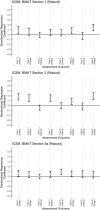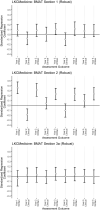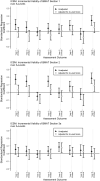BMAT's predictive validity for medical school performance: A retrospective cohort study
- PMID: 35514145
- PMCID: PMC9545404
- DOI: 10.1111/medu.14819
BMAT's predictive validity for medical school performance: A retrospective cohort study
Abstract
Background: Although used widely, there is limited evidence of the BioMedical Admissions Test's (BMAT) predictive validity and incremental validity over prior educational attainment (PEA). We investigated BMAT's predictive and incremental validity for performance in two undergraduate medical schools, Imperial College School of Medicine (ICSM), UK, and Lee Kong Chian School of Medicine (LKCMedicine), Singapore. Our secondary goal was to compare the evidence collected with published evidence relating to comparable tools.
Methods: This was a retrospective cohort study of four ICSM (1188 students, entering 2010-2013) and three LKCMedicine cohorts (222 students, 2013-2015). We investigated associations between BMAT Section 1 ('Thinking Skills'), Section 2 ('Scientific Knowledge and Applications') and Section 3a ('Writing Task') scores, with written and clinical assessment performance across all programme years. Incremental validity was investigated over PEA (A-levels) in a subset of ICSM students.
Results: When BMAT sections were investigated independently, Section 2 scores predicted performance on all written assessments in both institutions with mainly small effect sizes (standardised coefficient ranges: ICSM: 0.08-0.19; LKCMedicine: 0.22-0.36). Section 1 scores predicted Years 5 and 6 written assessment performance at ICSM (0.09-0.14) but nothing at LKCMedicine. Section 3a scores only predicted Year 5 clinical assessment performance at ICSM with a coefficient <0.1. There were no positive associations with standardised coefficients >0.1 between BMAT performance and clinical assessment performance. Multivariable regressions confirmed that Section 2 scores were the most predictive. We found no clear evidence of incremental validity for any BMAT section scores over A-level grades.
Discussion: Schools who wish to assess scientific knowledge independently of A-levels may find BMAT Section 2 useful. Comparison with previous studies indicates that, overall, BMAT seems less useful than comparable tools. Larger scale studies are needed. Broader questions regarding why institutions adopt certain admissions tests, including those with little evidence, need consideration.
© 2022 The Authors. Medical Education published by Association for the Study of Medical Education and John Wiley & Sons Ltd.
Conflict of interest statement
JC was formerly a member of UKCAT (UCAT) Research Committee but had left this role before engaging with the current study. Otherwise the authors have no conflicts of interest.
Figures



Similar articles
-
Can achievement at medical admission tests predict future performance in postgraduate clinical assessments? A UK-based national cohort study.BMJ Open. 2022 Feb 8;12(2):e056129. doi: 10.1136/bmjopen-2021-056129. BMJ Open. 2022. PMID: 35135776 Free PMC article.
-
Predictive validity of the UKCAT for medical school undergraduate performance: a national prospective cohort study.BMC Med. 2016 Sep 26;14(1):140. doi: 10.1186/s12916-016-0682-7. BMC Med. 2016. PMID: 27638740 Free PMC article.
-
The UKCAT-12 study: educational attainment, aptitude test performance, demographic and socio-economic contextual factors as predictors of first year outcome in a cross-sectional collaborative study of 12 UK medical schools.BMC Med. 2013 Nov 14;11:244. doi: 10.1186/1741-7015-11-244. BMC Med. 2013. PMID: 24229380 Free PMC article.
-
Insights into undergraduate medical student selection tools: a systematic review and meta-analysis.J Educ Eval Health Prof. 2024;21:22. doi: 10.3352/jeehp.2024.21.22. Epub 2024 Sep 12. J Educ Eval Health Prof. 2024. PMID: 39260821 Free PMC article.
-
Assessing the predictive validity of the UCAT-A systematic review and narrative synthesis.Med Teach. 2022 Apr;44(4):401-409. doi: 10.1080/0142159X.2021.1998401. Epub 2021 Nov 23. Med Teach. 2022. PMID: 34813410 Free PMC article.
Cited by
-
Predicting Success: A Comprehensive Analysis of High School and Admission Test Scores on Future Academic Performance of Dental Students.Cureus. 2024 Mar 16;16(3):e56279. doi: 10.7759/cureus.56279. eCollection 2024 Mar. Cureus. 2024. PMID: 38623127 Free PMC article.
References
MeSH terms
LinkOut - more resources
Full Text Sources

